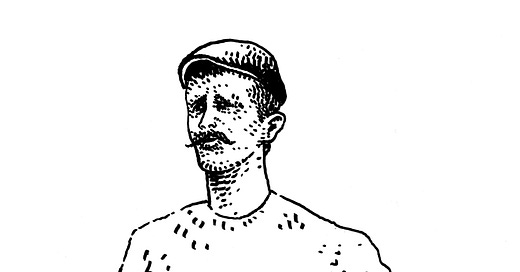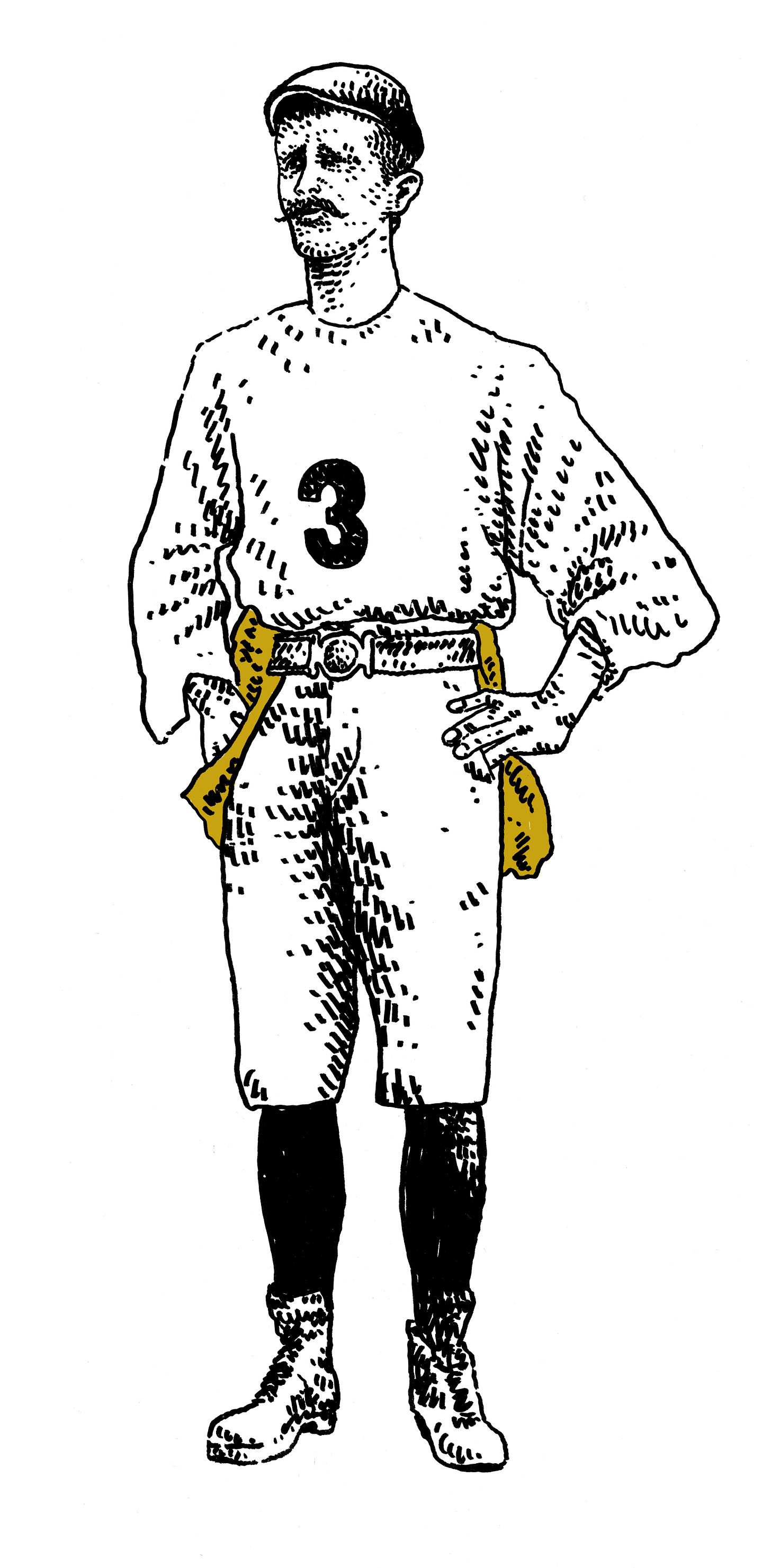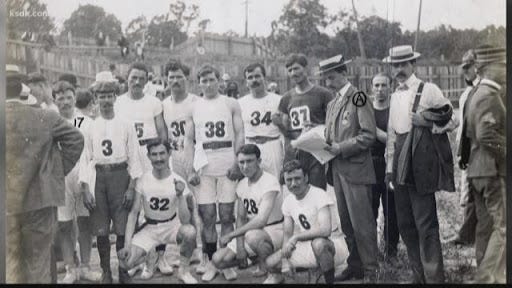El Andarín Carvajal: Cuban Mailman and Olympic Marathon Folk Hero
Carvajal was one of the most gifted marathon runners of his era, and one of the most memorable characters to grace the world sporting stage.
Welcome to Sports Stories, a publication at the intersection of sports and history. Sports Stories is written by Eric Nusbaum, illustrated by Adam Villacin, and delivered to your inbox every Tuesday.
If you’re not already a subscriber, please sign up here — we have both free and paid options. Paid subscribers are entitled to our eternal gratitude as well as cool swag including postcards featuring original art by Adam.
I never in a million years would have guessed that I would be into running, as an activity unto itself. Obviously, based on the existence of this newsletter, I love sports. Watching them, reading about them, playing them. Anybody who knew me as a kid or a teenager or even a college student playing sports knew that although I may have been fairly coordinated, could catch and throw a ball, etc, I was always slow as hell. I had asthma. But more than that, I just hated to run.
And yet here I am, 34 years old, jogging and huffing and puffing around town like a goofy movie villain, unable to chase down the speedy hero. The other day, I was running down by the waterfront in Tacoma and this old guy sees me and says to these other women nearby, “watch out, there’s a monster behind you.” I’m 6-4, and plodding and the women turn and laugh and I make an awkward joke about Sasquatch in the wild and then make an even more awkward turn onto another pathway for the sake of social distancing. It’s not elegant.
Anyway, this whole thing is very surprising to me. I track my runs in a little spreadsheet and I even bought some special socks that are supposed to help with arch support so I don’t get plantar fasciitis again. I started running just because I was looking for something efficient to do for exercise. Now I’ve arrived at a place where the exercise is secondary: what I enjoy is the quiet and the solitude. I like the routine of it, and I like pushing myself. I’ll never be graceful or a natural at running, but I’m okay with that. Some people are born runners and some people are not.
El Andarín Carvajal was a born runner. He was constantly in motion from the time of his birth in Havana in 1875 until he died in 1949. Running was why Carvajal was put on this earth; the act of running, the compulsion to run, the innate talent he was born with—these things animated a truly fascinating life. Carvajal, whose full given name was Félix de la Caridad Carvajal y Soto, was a character in the Mark Twain sense of the word. He lived a big life, he went a lot of places, and he was remembered wherever he went. His nickname, El Andarín, is also a description: of a person who is always going, always on the move.
As a boy, Carvajal’s family moved from Old Havana to the countryside just outside of town. He spent his childhood running up and down the nearby hills. It was clear from a young age that Carvajal, though short and very slight in stature, was extremely gifted. But before he could embark on any kind of a professional running career, Carvajal joined Cuba’s independence movement. He enlisted with the Ejército Mambí—guerrilla soldiers seeking freedom from Spanish rule—and quickly gained a reputation as a tireless and fearless messenger, often traveling upwards of 30 miles per day between towns. According to at least one story I found online, he was shot and fled briefly to Tampa to avoid falling into the hands of Spanish troops. It’s worth noting that Carvajal’s life, as it’d been told and retold, has become something of a tall tale. The truth is in there somewhere, but I’m not sure where exactly.
After Cuba won independence, Carvajal worked in Havana as a postman and a bellhop. He had little money but he became a well-known figure in the city: dapper and charming. Eventually, he began to put his quasi-celebrity to use, seeking out donations so that he might represent Cuba as a marathon runner at the 1904 Summer Olympics in St. Louis, Missouri. Carvajal would stand up on soapboxes, declaring his greatness and promising to bring back glory. He would run through the city wearing signs. At the time, there was no state support for Olympic athletes in Cuba. It was a self service kind of deal.
This was not necessarily an easy process, and Carvajal had his critics. A sportswriter from Carvajal’s own hometown outside Havana wrote a column where he said, “that slacker named Carvajal is good not for running the streets of our town but for sweeping them.” (Sportswriters haven’t changed a bit.) The story goes that upon hearing about this, Carvajal ran 20 miles to the newspaper office, knocked on the door, then beat the crap out of the writer.
Which is to say that he took himself seriously as an athlete. He wouldn’t have been so industrious in getting to the Olympics if he hadn’t also been serious about winning. Carvajal managed to make enough money to book passage to St. Louis for the 1904 games. (Other sources say that the mayor of Havana finally took pity on him and booked the passage himself.)
El Andarín was on his way to becoming Cuba’s first Olympic marathon runner.
But he nearly didn’t make it all the way there. Carvajal’s journey to the Games took him first to New Orleans, a city of endless temptation. Carvajal fell in with a group of gamblers and lost all the money he had saved up for the trip. Destitute in a foreign city, Carvajal supposedly began to walk north up along the Mississippi River to St. Louis. It was hundreds of miles, but between walking and hitching rides, he was able to reach St. Louis in time for his event.
Carvajal reached the starting line hungry and out of shape and tired. Where other runners had t-shirts and shorts and running shoes, Carvajal had no such equipment. It was August in St. Louis and the temperature was around 90 degrees. Carvajal stood in the staging area wearing his heavy postman boots, long pants, and a baggy long-sleeved shirt. Just before the starting gun, an American athlete named Martin Sheridan took a pair of scissors to Carvajal’s pants and cut them into shorts. And then the race began.
Carvajal took off to a commanding early lead despite the fact that he had not eaten in two days and by all reports, he stopped repeatedly to chat with spectators along the course. Carvajal had never particularly believed in pacing one’s self. He was mostly self-trained and his notions about running had always been straightforward: to run far and run fast and run until you can’t go anymore. This had generally served him exceptionally well. But 26.2 miles is a long distance. It’s a long distance with proper equipment and with rest and with decent nutrition. Carvajal had none of these things. Toward the last third of the race, he began to slow, but he believed himself to be in luck when the course took him by an orchard.
Here, Carvajal reportedly picked five green apples, thinking he could fuel up on the run as he finished the race. Other stories have it differently: that he sat down in the orchard to feast in luxury; that they were peaches and not apples; that he had pilfered the peaches from some sports writers who were following along in their car. But there is no disagreement about what happened next: the fruit Carvajal ate turned out not to be ordinary green apples, but unripe apples. He soon became badly ill with all the stomach ailments one might imagine and had to step off the course and find a quiet place to take care of business.
Miraculously, Carvajal managed to regain his strength and return to the race. Despite the sickness, the clothes, the long and tiresome journey to St. Louis, he still finished in fourth place.
The 1904 Olympics would be the peak of Carvajal’s international career. But he remained a runner for the rest of his life. Back in Havana, he would rent himself out as a living billboard, and became a well-known site hustling around the streets. He was not bound by the 26.2 miles of the marathon—the object for him was simply running. After all, he was El Andarín Carvajal, not El Maratón Carvajal. He performed frequent demonstrations, and would challenge international runners to races in and around Havana.
At 55 years old, Carvajal ran the entire length of Cuba along the country’s main highway from the town of Guane, Pinar del Río, to the city of Santiago, a distance of nearly 700 miles. Then he turned around and ran back.
All the while, he lived in poverty. For the final two decades of his life, he slept in a small shack under a bridge in Havana. Even when you’re a charming personality like Carvajal, running is a solitary activity. And Carvajal was very much alone.
Toward the end of his life, he performed a short running demonstration at a professional ballgame in Havana. He was 70 years old.
“This is to show you that I still run,” he told the crowd.
Related Reading
There were some great old English-language newspaper stories about Carvajal from the early 1900s. My favorite was an article from the Cincinnati Commercial Tribune of May 7, 1905. But basically any big paper publishing around the turn of the century would have had a mention or two of Carvajal. In Spanish, I appreciated this piece by Wilfredo Díaz García and the well-sourced writeup on EcuRed, which is Cuba’s domestic version of Wikipedia.
Finally, if you dig both running and subscribing to newsletters, you should check out Paul Flannery’s “Running Probably.” Paul was one of my favorite NBA writers for a long time, and now he writes about running in a philosophical, “it’s not just about running” kind of way that I sincerely appreciate.
Marathon Madness
You could argue that Carvajal’s story wasn’t even the craziest part of the 1904 Olympic Marathon. The ‘04 games were kind of a mess in general: marred by extremely flagrant racism and a sort of cheap carnival vibe that extended from the concurrently held World’s Fair in St. Louis.
The marathon was no exception. The course in fact fell just short of official marathon distance, clocking in at about 25 miles. But it was brutal: full of hills, traffic, crossing active train tracks and rough terrain. Runners found themselves falling one by one to cramps. One American runner, Thomas Hicks, begged his support crew for water and food (Carvajal could have used a support crew), but they refused. Instead, for some reason, they decided to force him to consume strychnine and egg whites as he ran. This was obviously a terrible choice, and Hicks grew deeply ill. It was also, per this wonderful writeup on the 1904 marathon from Smithsonian Magazine, the first documented use of drugs for performance “enhancement” during an Olympics.
The winner of the race at first appeared to be an American bricklayer named Fred Lorz. But it turned out Lorz too had suffered cramps, and had ridden 11 miles in a car before jumping back onto the course.
Which brings us back to the drug-fueled Hicks. Here’s Smithsonian’s Karen Abbot:
Hicks, the strychnine coursing through his blood, had grown ashen and limp. When he heard that Lorz had been disqualified he perked up and forced his legs into a trot. His trainers gave him another dose of strychnine and egg whites, this time with some brandy to wash it down. They fetched warm water and soaked his body and head. After the bathing he appeared to revive and quickened his pace. “Over the last two miles of the road,” wrote race official Charles Lucas, “Hicks was running mechanically, like a well-oiled piece of machinery. His eyes were dull, lusterless; the ashen color of his face and skin had deepened; his arms appeared as weights well tied down; he could scarcely lift his legs, while his knees were almost stiff.”
He began hallucinating, believing that the finish line was still 20 miles away. In the last mile he begged for something to eat. Then he begged to lie down. He was given more brandy but refused tea. He swallowed two more egg whites. He walked up the first of the last two hills, and then jogged down on the incline. Swinging into the stadium, he tried to run but was reduced to a graceless shuffle. His trainers carried him over the line, holding him aloft while his feet moved back and forth, and he was declared the winner.
Carvajal, meanwhile, finished the race on his own. Then, after a short rest, he walked alone from the finish line to his boarding house a few miles away.
Sports Stories is an independent publication, and our best chance at growing is by word of mouth. If you have dug this or any issue of Sports Stories, please do us the solid of sharing it with a person you think might dig it too.
Thanks for reading. We’ll see you next week.





A great read as always, but just to mention that Martin Sheridan was Irish and comes from a small village near me in County Mayo, Ireland.
https://www.irishtimes.com/news/achievements-of-athletic-giant-of-bohola-recorded-in-biography-1.142361